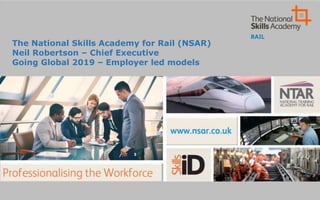Mr Neil Robertson
- 1. The National Skills Academy for Rail (NSAR) Neil Robertson ®C Chief Executive Going Global 2019 ®C Employer led models
- 3. 3 Today°Øs Workforce (1) ®C Population of 223,856 Gender imbalance is decreasing, from approximately 4% in rail engineering four years ago, the figure is now closer to 10%. More needs to be done though. Operations figures contain all TOCs. There are more staff at Level C than B, indicating multiple management layers
- 4. 4 Today°Øs Workforce (2) ®C Population of 223,856 Asset Type Region
- 5. 5 Investment Plans (1) These charts show total planned investment until end of CP8 depicted over time, then proportions of investment by organisation, work type and asset. DfT is Rolling Stock By Region (?millions) By Work Type (?millions) ¶≤ Investment (?millions) Investment(?millions)
- 6. 6 Future Workforce (2) : Outputs : 2020 = 226,563; and 2024 = 203,038 Charts showing the total predicted workforce for 2020 and 2024 compared to today°Øs workforce presented by skill level (left), and proportionally by work type (right). By Skill Level Today 2020 2024
- 8. There is evidence of significant wage inflation in rail construction; a significant contrast with construction as a whole. This would be unlikely to occur if sufficient, trained resource was available. Notes: ? In the construction sector overall the cost per worker only went up by 5% between 2008 and 2014. ? In rail construction the average employee cost rose by 85% over this same timeframe. ? This could be due to a lack of skills planning (so demand exceeding supply and driving up wages) or due to outsourcing the lowest cost roles (thereby shifting up the average). ? If it were due to outsourcing lower cost roles we would expect the margin to increase, as no organization would outsource low cost roles so that they cost more. ? All things being equal, if the employee cost had stayed flat, the productivity uplift (ie the efficiency component) would only have been 15% in Rail. 0.00 10.00 20.00 30.00 40.00 50.00 60.00 70.00 80.00 90.00 Avg Employee Cost 2008 2014
- 9. The study suggests that there are opportunities to avoid significant (10-30%) over-run capital costs and deliver (10-40%) efficiencies. We are targeting 30%. 50%-60% Optimally Spent Efficiencies Missed Excess Costs A: Avoid the cost of conflict and the cost of poor capability and create an environment for efficiency 6 C: Stop restarting the learning curve on people, processes, products, contracts and technology 4 D: Take the right risks and stop paying for excessive design redundancy and unrealistic risk transfer 4 E: Use °∞digital / don°Øt build°± to get the outcome without concrete 3 F: Use our scale for robust asset data, manufacturing, R&D and asset standards 4 B: Avoid the costs of skills shortages 9 ?300 Billion of Infrastructure Spend 9
- 10. current digital apprenticeships Apprenticeship Title (Approved) Level Cyber Intrusion Analyst 4 Cyber SecurityTechnologist 4 DataAnalyst 4 Digital andTechnology Solutions Degree 6 Digital Marketer 3 InfrastructureTechnician 3 IS Business Analyst 4 ITTechnical Salesperson 3 Network Engineer 4 Software Developer 4 Software DevelopmentTechnician 3 SoftwareTester 4 Unified CommunicationsTechnician 3 Unified CommunicationsTroubleshooter 4 Digital Engineering (sits within construction) 3 Digital Apprenticeship Title (in development) Level Community Coordinator/Associate Community Manager 4 Cyber Security Technical Professional Degree 6 Data Scientist Degree 6 Digital Technology Solutions Specialist Degree 7 Digital Applications Technician 3 Digital Marketer Degree 6 Digital User Experience (UX) Professional Degree 6 IT Solution Technician 3 Network Cable Installer 3 10
- 11. Digital -What°Øs the scale of the challenge? ? How many people will be affected? ? In excess of 200,000 workers (Includes operations (both train and infrastructure), asset maintenance, and relevant parts of corporate services and renewals / enhancements) ? Assume all need either: ? Upskilling (modest training - 55% of the requirement ) or ? Reskilling (more training - 40% of the requirement ) or ? As a new entrants (apprenticeships - 5% of the requirement) ? So 110,000 need upskilling, 80,000 need re-skilling and 10,000 new Apprenticeships ? Which equates to approximately ?600m of training and education cost to the industry, however up to ?200m could be recoverable through theApprenticeship Levy 11
- 12. What°Øs the evidence on returns for employer led model? ? Individuals ®C better job, increased salary ? Companies ®C pay back in 2 -3 years, increased loyalty ? Government ®C doubles its investment ? Overall return on investment is 3:1 ? Market failures in skills supply still arise because of the time lag and upfront costs ? Some have questioned have employers got too much control ®C who could moderate this (regional, sectoral, professional)? 12













